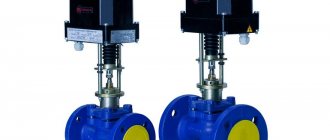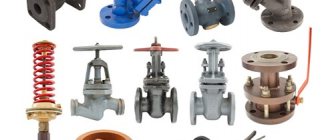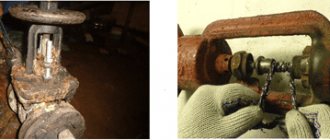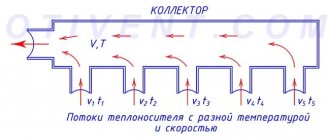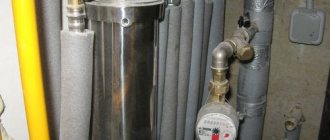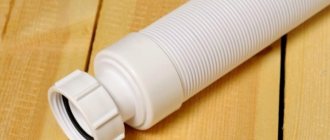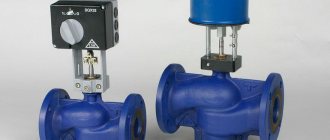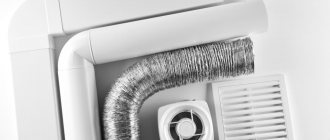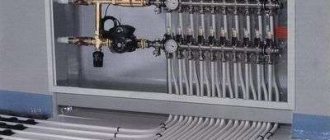It is impossible to imagine life in a modern country house or apartment without toilets; internal components installed in the cistern are responsible for their functioning and operating modes. When installing them, specialists or owners most often install shut-off valves for a toilet with a bottom connection.
Before buying a toilet, you need to decide not only on its model, but also on the type of liner. To do this, you should know the difference between the lateral and lower systems; it would not hurt to study their varieties.
Rice. 1 Shut-off valve for toilet with bottom connection
Design of a typical drain tank
A standard toilet cistern made of ceramics (faience, porcelain) consists of the following components:
- Water reservoir. Typically, water is collected in a roughly rectangular bowl with a capacity of at least 6 liters. This indicator is accepted as a standard; in rare models, the tank volume reaches 9 liters. The use of 6-liter tanks allows you to implement an economical drain mode, in which pressing one button will drain half of the 3-liter volume, and turning on the other will completely empty the container.
- Shut-off valves. Designed to supply water to the tank and automatically stop it after filling the container. The principle of its operation is based on the raising of the float when the tank is filled, which in turn is connected to the locking mechanism. Based on the location of fastening, it is divided into fittings with bottom and side connections. It is located in the side of the tank at some distance from the center.
- Drain fittings. Holds water in the bowl, controls its drainage and performs overflow protection functions. It has different designs with external controls in the form of levers or buttons. It is located in the center of the tank above the drain hole.
Rice. 2 Tank design with bottom supply
A button gets stuck or stuck: what to do?
To the listed malfunctions of the flush tank, you can add sticking or sticking of the button. This is when you press the button, release it, and it remains in the socket, so the draining does not stop. You have to press the button mechanism several times to return the button to its original position. The problem is solved by cleaning the buttons themselves from rust and dirt. Monthly use of cleaning products to maintain the sanitary condition of the buttons allows you to get rid of this problem once and for all. Some people simply pour a small amount of detergent directly into the push-button mechanism. Under the influence of special means, all dirt dissolves and the buttons do not stick.
As you can see, it is quite possible to independently repair a toilet cistern with a button. By spending a little time studying the structure and operating principle of the valve mechanisms, you can repair the cistern without outside help. Of course, if plumbing work does not bring you any pleasure, then you should turn to professional craftsmen who will cope with any malfunction of the tank and toilet in a matter of minutes. Real professionals only need to take one look at the toilet to understand the nature of the problem. To troubleshoot a problem, plumbers usually always have everything they need with them.
Operating principle of toilet fittings
All shut-off valves work according to the following principle.
As soon as the drain valve opens after pressing the button or lifting the lever head, water leaves the tank and the float in it drops.
In turn, the float bulb is connected through a lever or rod to a locking mechanism, the passage channel of which is blocked by an elastic rubber valve.
As a result of the float lowering, the valve moves, opening the channel, and water begins to flow into the tank. As soon as the water level reaches a certain point, the previously constantly moving valve finally closes the passage channel and the access of water to the tank stops.
Shut-off valves for toilets with bottom connections and their advantages
Most modern toilet models are produced with a bottom water supply to the tank and this is due to the following features:
- Compared to a side connection, a toilet with a bottom water supply looks more aesthetically pleasing because the hose is not visible behind the bowl.
- When water is supplied from below, the flow immediately enters the water masses. This significantly reduces noise compared to side inlet, where water falls into an empty space for some time.
- Since the underwater fittings below are not directly accessible, they are rarely damaged and therefore do not need repairs as often.
- The disadvantages of the lower line include not very convenient access in case of repair to the fastening nuts under the bowl.
- Also, the bottom line is a little more difficult to install and check for leaks.
Rice. 3 Bottom connection nodes
Shut-off valve arrangement with bottom connection
Almost all manufactured toilet models have a bottom water supply under the tank. A standard bottom knot consists of the following elements:
- Float. It is made in the form of a short glass with a slot or hole for moving along a guide part. In some rare designs there is a horizontal float on the rod.
- Guide. It is made in the form of a rectangular strip or a section of a cylindrical pipe.
- Lever rod. On one side it is attached to the float, and on the other - to the locking unit.
- Diaphragm valve. It is located inside the inlet pipe and is connected to the rod through a pusher.
- Check valve. Some manufacturers install it, although in most cases you can do just fine without it. Naturally, the check valve prevents water from flowing out of the tank back into the pipeline.
- Fasteners Also, any bottom connection unit includes rubber gaskets and a fastening union nut.
Weak drain: methods of elimination
If a detailed inspection of all structural components reveals that the water level entering the tank meets all regulatory standards, but the toilet flush is extremely weak, you should check the tank outlet and toilet flush for blockages. It is possible that the hose has slipped and created an obstruction to the water at the bowl level. Often foreign objects are found under the pear, which can be removed simply by hand or using tweezers. If the cause of the blockage has sunk deeper, then sometimes you have to remove the tank to clean all the holes.
Dominant malfunctions of tank fittings and ways to correct or prevent them
Installed fittings in a toilet cistern are subject to a number of fairly common malfunctions, for the correction of which experts have developed specific recommendations.
- If the float fails, the only solution is to replace the entire assembly, which also includes the lever. There are samples on sale with different arm lengths, so you need to know exactly the features of your model, and it’s even easier to take the removed reinforcing tandem with you for comparison.
- Sometimes there is deformation of the reinforcement for the manufacture of which plastic was used. One of the reasons is excessive pressure during flushing. The second, less common impetus for the loss of elastic properties and strength of plastic is the actions of some home craftsmen to make improvements to the device. Trying to level out fogging on the outer plane of the tank, they connect the system to hot water. Such exposure becomes an unfavorable factor for plastic, parts of which become unusable.
- It is a mistake to install imported structures in the cistern. The membranes of such devices are aimed at a fairly high level of water quality. Their operation in other conditions significantly reduces the standard service life.
- Cheap parts sold in markets or in handicraft workshops, as a rule, do not have the quality indicators required by technical regulations and quickly become unusable.
Shut-off valves for toilets with side connections
All Soviet-era toilets were made with side connections. The unit was attached to one of the walls of the toilet; a rigid polymer hose was connected to it, the other end of which was screwed to the water pipe. Inside there was a plastic float on a brass rod.
For flushing, a handle was attached to the side, which was connected through a wire to a rubber valve fixed in metal guides. In other designs, the valve was connected to a handle that was located on top of the tank lid.
Fill valve with horizontal float
Modern fittings for a toilet with side connections are structurally not much different from the old Soviet ones. The filler unit with a valve that shuts off the flow is attached to the side of the toilet, and the movement of the membrane is controlled by a horizontally located float on a metal rocker rod.
Water enters the tank through a small-diameter lower pipe in the head of the filler unit; it is fitted with a polymer tube, which simultaneously reduces noise.
The operating principle of such a system is quite simple. When the tank is filled, the float lifts a rocker arm, which, through a pusher, presses on the membrane, which in turn closes the water channel.
Fig.6 Lateral fittings with vertical float
Fill valve with vertical float
If someone still has an old Soviet toilet with a side connection, it is quite possible to install a vertical unit instead of a horizontal float system that has become unusable.
The design is not very complicated, and externally it looks like a filler pipe with a vertical rod connected to it. A float moves along the rod, which, rising, presses through a lever on the pusher and the elastic membrane that blocks the channel. Also, the rod is made hollow inside and water flows through it into the tank.
In other designs, the float moves along its guide, and water is supplied to the tank through a separate tube.
Since not all toilet walls are located vertically relative to the water horizon, an oblique washer is included in the fastening of the side mechanism. It allows you to set the position of the filler unit strictly vertically when twisting it.
Rice. 7 Drain fittings complete with filler
Related article:
Replacing pipes in the bathroom and toilet - choice of pipe material, tools, installation methods . It is possible that before installing a pipe box in the bathroom, you also need to replace old pipes with new ones, and you can read how this is done in a separate article!
Plumbing diagram
And a few words about how to properly organize an autonomous water supply network at your dacha. First of all, the issue of the source of water supply is resolved. After which the pump is selected according to its installation type. That is, these two criteria are inextricably linked. And the second comes out of the first.
And now about the layout. If submersible or borehole models of pumping equipment are used in the water supply system, then surveying the location of the devices will not be necessary. As for surface aggregates, there are two options:
Layout of a surface pump in the basement of a house Source moikolodets.ru
Sometimes a special room is allocated for a surface pump, which is built on the street next to the cottage. It must be insulated.
As for the pipework, these are plastic pipes that are laid at a shallow depth, but must be insulated. Fortunately, you can find special thermal insulation materials for pipes on the market
Particular attention is paid to laying pipes inside the house. Typically, such a passage is planned at the stage of forming a country house project
Because the shorter the distance from the source of water intake to the cottage, the better: less material consumption, the pressure and productivity of the water supply does not decrease. Usually the installation inside the house is carried out either through the foundation of the building or through the wall.
Recommendations for selection
Most toilets are produced and sold with ready-made shut-off and flush valves.
If it is not included in the package or requires replacement, then the following tips may be useful when choosing it:
- When old fittings are replaced in a tank, it is desirable that the new one be from the same manufacturer and of the same brand.
- When purchasing, it doesn’t hurt to make sure that all pads are soft and elastic. You should not choose products with rubber seals that are too thin, as this will complicate the fight against leaks.
- You can visually inspect the plastic reinforcement and make sure that there are no defects in it in the form of cracks, burrs, or irregular shapes.
- Although the fittings are sold in packaging, after damage it is difficult to return it to the seller, it is still better to make sure that the valve in the outlet assembly and the float in the shut-off assembly move easily.
- A more reliable fixation to the tank is ensured by a locking mechanism with a brass threaded coupling and nut. The metal connection allows the rubber gaskets to be pressed more tightly to the surface of the tank, while at the same time making self-unscrewing more difficult.
Rice. 9 Complete set for mounting the bottom line
Article on the topic:
How to close pipes in a toilet: various options and technology for carrying out the work. Choosing a design for a box, what types of installation there are for various structures, as well as installing a box in a toilet yourself, read about all this in a separate article!
- Almost all manufacturers produce fittings with two buttons for operating the tank in normal and economy modes. This is the best option for drain fittings that should be purchased.
- The easiest way to determine high-quality fittings from a number of presented ones is to weigh them in your hands. The heavier the product, the more reliable it will be in operation.
- It is important to pay attention to the dimensions of the mounting bolts of the reinforcement. On low-quality products they have a small cross-section and small size; in high-quality fittings (Alcaplast) the bolts are much more massive.
- Companies that produce the highest quality fittings: Czech Alcaplast, Turkish Nova, Russian ANI Plast.
Useful tips
And some recommendations from experts:
- Before purchasing pumping equipment, it is necessary to carry out calculations for consumers. That is, calculate the optimal ratio of pump performance and total consumer consumption.
- A preliminary piping scheme is developed, which takes into account all consumers, regardless of their seasonal or off-season use.
- It is necessary to correctly connect the pump to the power supply network. There are many nuances here, so a professional electrician is involved in this matter.
- The owner of the dacha must first decide whether to buy all materials and equipment separately or purchase a ready-made pumping station. It cannot be said that one of the proposed options is better than the other. Therefore, it is better to consult with specialists who will study the features of the dacha and the source of water intake.
